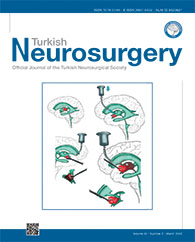2Pontifical Catholic University of São Paulo School of Medical and Health Sciences, Department of Medicine, Sorocaba, Brazil
3Hospital de Clínicas de Porto Alegre, Porto Alegre, Brazil
4Hospital Padilla, Department of Neurological Surgery, Tucumán, Argentina
5Pontifical Catholic University of São Paulo, Department of Surgery, Sorocaba, Brazil
6Pontifical Catholic University of São Paulo, Department of Neurology, Sorocaba, Brazil DOI : 10.5137/1019-5149.JTN.33441-20.3 AIM: To study the operative approaches for posterior inferior cerebellar artery (PICA) aneurysms or understanding the different pathologies that can affect this artery, and to present detailed knowledge of this artery?s anatomy.
MATERIAL and METHODS: The present study analyzed the different variations of the PICA?s first two segments, the anterior medullary and lateral medullary segments, regarding the number of trunks, their emergency site, and the presence or absence of hypoplasia of this artery, through microsurgical dissection of 23 fresh cadaver brains.
RESULTS: Some striking variations were found, such as the absence of the left vertebral artery in one of the brains and the emergence of any PICA in another two brains studied. Moreover, variations such as hypoplastic arteries, missing trunks on one side and double or triple trunks, different emergence sites, significant PICA emergence from the superior part of the vertebral artery (59% of the trunks), and asymmetries between the right and left sides were recorded. The double origins of non-hypoplastic PICAs were found in 17% (n = 4) of patients.
CONCLUSION: The results obtained in the present study indicated the great importance of the studies and reviews on the different topographies of PICA; these studies and reviews expand the knowledge and consensus on the characteristics and implications of PICA?s variations. The clinical implication of this knowledge and consensus is obtaining the best surgical strategies for clipping aneurysms and, in addition, the best choices for occlusion of the vessel affected if the territory of the main vessel has an adequate collateral circulation. From the results of the present study, it is evident that there was a significant PICA emergence from the superior part of the vertebral artery and that the double origin of non-hypoplastic trunks was also found in some patients; the latter is associated with a greater chance of aneurysms and other additional complications.
Keywords : Anatomical study, Cerebellum, Intracranial aneurysm, Posterior cranial fossa, Posterior inferior cerebellar artery




